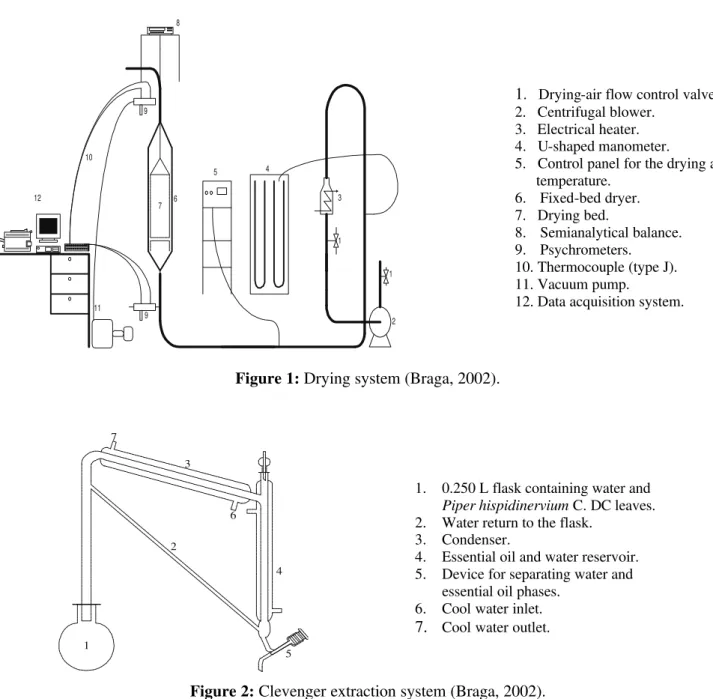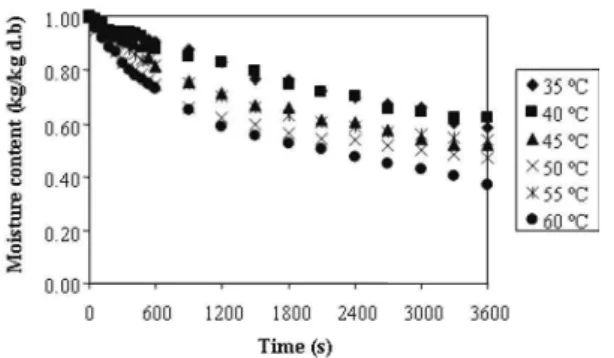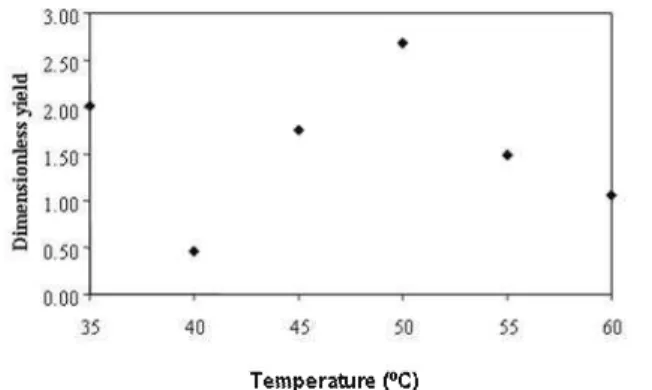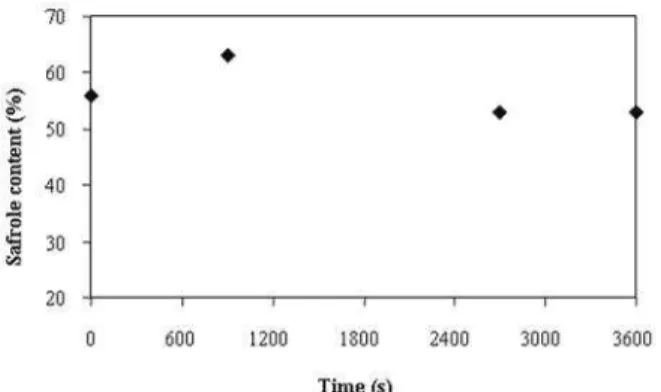ISSN 0104-6632 Printed in Brazil
www.abeq.org.br/bjche
Vol. 22, No. 02, pp. 257 - 262, April - June, 2005
Brazilian Journal
of Chemical
Engineering
THE EFFECTS OF FIXED-BED DRYING
ON THE YIELD AND COMPOSITION OF
ESSENTIAL OIL FROM LONG PEPPER
(
Piper hispidinervium
C. DC) LEAVES
N. P. Braga
1, M. A. Cremasco
1*and R. C. C. R. Valle
21
School of Chemical Engineering, Laboratory of Thermo-Fluid-Dynamics, P.O. Box 6066, 13083-970, Campinas - SP, Brazil.
E-mail: cremasco@feq.unicamp.br
2Regional University of Blumenau, Chemical Engineering Department,
P.O. Box 888, 89010-971, Blumenau - SC, Brazil.
(Received: October 20, 2004 ; Accepted: February 13, 2005)
Abstract -Piper hispidinervium C.DC (Piperaceae) is popularly known as long pepper. It grows in degraded areas of natural fields in the state of Acre, Brazil. Its leaves are 3 to 4 % essential oil rich in safrole, within the range of 90 to 94 %. In the chemical industry, safrole is an important raw material, mainly due to two of its derivatives: heliotropin, which is widely used as a fragrance and flavoring agent, and piperonyl butoxide (PBO), a vital ingredient of pyrethroid insecticides. Natural pyrethrum in particular would not be an economical insecticide without the synergistic effect of PBO; therefore, its industrial future is linked to the continued availability of PBO. As a fragrance, safrole has many applications in household products such as floor waxes, polishes, soaps, detergents and cleaning agents. In this work, leaves were dried in a fixed-bed dryer using different drying-air temperatures (35, 40, 45, 50, 55 and 60 ºC) and drying times (900, 2700 and 3600 seconds). Essential oil was extracted by cohobation (meaning that the condensed water that comes out of the flask is recycled) from both raw and dried leaves. The essential oil yield and safrole content are susceptible to rapid loss of moisture by Piper hispidinervium C. DC leaves. It was observed that the essential oil yield increased twice after the drying process. However, safrole content decreased about 20 percent when temperature was above 50 ºC and drying times were more than 2700 minutes.
Keywords: Long pepper; Drying kinetics; Safrole.
INTRODUCTION
Piper hispidinervium C.DC (long pepper) is rich in essential oil containing safrole (up to 90 %), a volatile constituent. Safrole is converted by the chemical industry into two important derivatives: heliotropin, which is widely used as a fragrance and flavoring agent, and piperonyl butoxide (PBO), a vital ingredient in pyrethroid insecticides.
aromatic plant has been estimated at about 1300 tons. Essential oil is extracted from the fresh leaves of
Piper hispidinervium C. DC by steam distillation. Before extraction, the leaves are dried to remove high-level moisture. In aromatic plants, like Piper hispidinervium C. DC, many interesting compounds are lost during drying. This is explained by the high moisture, in the leaves, oil glands at the beginning of drying. This moisture moves by diffusion to the leaf surfaces and drags essential oil with it. The proposed mechanism explains the loss of aromatic compounds (Cremasco, 2003). The aim of this research was to study the effect of fixed-bed drying on the yield and composition of essential oil from Piper hispidinervium C. DC leaves.
MATERIALS AND METHODS
Piper hispidinervium C. DC leaves were dried and the essential oil extracted at the Department of
Thermo-Fluid-Dynamics (DTF), School of Chemical Engineering, State University of Campinas (Unicamp). The gas chromatograph analysis of the essential oil were done at the Emílio Goeldi Museum Laboratory in Pará (MPEG), Brazil.
Materials
Fresh Piper hispidinervium C. DC leaves used in the drying and extraction runs came from a natural reserve at the Regional University of Blumenau, in the Brazilian South. Piper hispidinervium is native of Acre in northern Brazil, which has the smallest production, but the highest safrole content in the essential oil. Leaves were sampled in an aleatory way. The fresh leaves were transported by plane and dried immediately after arrival. The remaining materials were stored in a refrigerator at 20 ºC.
The physical and thermal properties of Piper hispidinervium C. DC leaves are shown in Table 1.
Table 1: Physical and thermal properties of Piper hispidinervium C. DC leaves (Cremasco, 2003).
Average Moisture (%d.b)
Specific Gravity (kg/m3)
Pore Diameter
(A)o
Porosity (%)
Heat Capacity (cp)
(J/kgºC)
Thermal Conductivity (λ) (W/mºC)
401.36 1.56 992 46.73 3.50 1.9x10-4
Experimental Equipment
Piper hispidinervium C. DC leaves were dried in a system insulated with rock wool and corrugated aluminum. The air was heated electrically with four 400 W resistances. A type T thermocouple controlled air temperature at the inlet of the dryer. A centrifugal blower supplied air to the drying bed. Air flow rates were controlled by two valves and measured with a Pitot tube. The dryer was connected to a data acquisition system, as shown in Figure 1. The acquisition system was used to obtain data on dry bulb and wet bulb temperature over time. These data were later used for calculation of the air moisture content at the dryer’s inlet and outlet.
The moisture content was measured by weighing the leaves during drying using an external balance connected to a basket within the dryer chamber.
Two psychrometers were placed at the inlet and the outlet of the dryer in order to measure the absolute humidity of the drying air. They were connected to a vacuum pump to guarantee a
drying-air velocity over 3 m/s to apply the wet bulb theory and, consequently, the determination of air humidity at the dryer inlet and outlet. The extraction was done in a Clevenger MA553 distiller with a capacity of 0.250 L (Figure 2). The mass of Piper hispidinervium C. DC leaves used in the extraction was weighed on an analytical balance, BG400 Gehaka, accurately to 10-6 kg. After extraction, the essential oil was mixed with water. As the oil is denser than water, it was easily separated by gravity. Residual water was removed by centrifugation (Centribio, model 80-23) and the oil was stored in a refrigerator at 5 ºC until analyzed by gas chromatography.
Experimental Procedure
moisture loss was monitored at 300 second interval, as described above. The drying time was 3600 seconds. The initial moisture was determined in samples before the start of drying. Both fresh and dry leaves were used in the. The mass of Piper hispidinervium C. DC leaves and distilled water used in the extractions were 0.030 kg and 0.150 L, respectively. Essential oil yield and safrole content were determined before and after drying. The safrole content was analyzed using an HP gas chromatograph fitted with a DB-5 column (fused silica capillary) 30 m long and with a 0.25 µm film
thickness. The column was operated at a heating rate of 3ºC/min, starting at 60 ºC and ending at 240 ºC. The injector and detector (FID) temperatures were 200 ºC and 250 ºC, respectively. The “split-splitless” method was used. The analysis used 2.0 µL of essential oil solubilized in 1 mL of n-hexane. The essential oil yield, expressed as the ratio of mass of oil distilled from fresh leaves before drying to mass of fresh leaves, is given by Equation (1).
(
)
ofl
m
Rd %wb 100
m
= × (1)
1 7
1
2 3
4 5
6 8
9
9 10
11 12
1. Drying-air flow control valve. 2. Centrifugal blower.
3. Electrical heater. 4. U-shaped manometer.
5. Control panel for the drying air temperature.
6. Fixed-bed dryer. 7. Drying bed.
8. Semianalytical balance. 9. Psychrometers.
10. Thermocouple (type J). 11. Vacuum pump.
12. Data acquisition system.
Figure 1: Drying system (Braga, 2002).
1
2 3
4
5 6
7
1. 0.250 L flask containing water and
Piper hispidinervium C. DC leaves. 2. Water return to the flask.
3. Condenser.
4. Essential oil and water reservoir. 5. Device for separating water and
essential oil phases. 6. Cool water inlet. 7. Cool water outlet.
RESULTS AND DISCUSSION
This section analyzes the change in essential oil yield and safrole content as a function of drying-air temperature, wet load, drying-air velocity and drying time.
Experimental conditions are given in Table 2. Figure 3.1 shows experimental results for the drying kinetics curves over time expressed in kg of water/kg of dry material as functions of drying-air temperature. The drying-air velocity was kept at 0.56 m/s and the wet load was 0.150 kg. The results indicated that the curves at 35 and 40 ºC and at 45,
50 and 55 ºC were practically identical. This behavior might be due to different initial conditions. However, the drying-air temperature affected the increase in drying rate.
Figure 3.2 shows the effect of wet load, with a drying time of 3600 seconds, a drying-air temperature of 50 ºC and a drying-air velocity of 0.56 cm/s. These studies corroborate results found in a previous study (Cremasco, 2002), which showed that high temperatures and low loads increased the drying kinetics. Therefore, the smaller the material load, the smaller is the amount of energy necessary for the process.
Table 2: Experimental conditions used in this work.
Experiments n.
Temperature (ºC)
Wet load (kg)
Air Velocity (m/s)
Time (s)
1 35 0.150 0.56 3600 2 40 0.150 0.56 3600 3 45 0.150 0.56 3600 4 50 0.150 0.56 3600 5 55 0.150 0.56 3600 6 60 0.150 0.56 3600 7 50 0.150 0.28 3600 8 50 0.150 0.56 900 9 50 0.150 0.56 2700 10 50 0.250 0.56 3600
Figure 3.1: The effect of air temperature on the drying kinetics of Piper hispidinervium C. DC leaves.
Figure 3.2: The effect of material load on the drying kinetics of Piper hispidinervium C. DC leaves.
The essential oil yield of the wet leaves is between 0.2 % and 1.3 %, which is well below the values of between 2.5 % and 4.5 % found in the literature (Costa, 1999). This may be associated with two factors: the seeds of the planted species and the collected material used in this study both had a low essential oil yield. The best procedure would be to
collect parts of the plant, and not to plant seeds directly into the soil.
Piper hispidinervium C. DC leaves is shown in Figure 3.3. Within the range of the parameters used in this work, for temperatures up to about 50 ºC, essential oil yield practically doubled after drying; the increase is smaller above this temperature.
The effect of material load, under the same operating conditions as those employed in the experiments presented in Figure 3.2, is shown in Figure 3.4. Even though this figure has only two points, it shows that the smaller the size of the load, the higher is the essential oil yield. This is related to the fact that more moisture is removed when one works with smaller loads, as indicated in Figure 3.2. However, it is not conclusive, as shown in Figure 3.3, that increasing the drying-air temperature decreases the essential oil yield.
Another important parameter to be evaluated is the effect of drying residence time on the essential oil yield to evaluate the extent of the effect of moisture removal. The results are presented in Figure
3.5, which shows that this effect is practically negligible after 2700 seconds.
To analyze the effect of drying on the safrole content of the essential oil, extraction from fresh leaves was carried out. The result was an average concentration (mass percentage) of 57 %, which is well below that reported in the literature (safrole content of 90 %) (Costa, 1999).
Figure 3.6 shows the safrole content in the essential oil from dried leaves. Under the same operating conditions as those for the experiments in Figure 3.1, the safrole content decreases about 16 % when temperature increases from 35 ºC to 50 ºC, and then remains practically constant up to 60 ºC. A similar effect was found for the drying residence time. In other words, when the leaves are dried over a longer drying time, the safrole content decreases. Figure 3.7 shows that there is a significant decrease in safrole content up to 2700 seconds, when it practically levels off.
Figure 3.3: The effect of drying-air temperature on essential oil yield.
Figure 3.4: The effect of material load on essential oil yield.
Figure 3.5: The effect of the drying residence time on essential oil yield.
Figure 3.7: The effect of drying residence time on safrole content.
Figure 3.8: The effect of drying-air velocity on safrole content.
CONCLUSIONS
Essential oil yield and safrole content were affected by the removal of moisture from Piper hispidinervium C. DC leaves. Under the operating conditions used in this report, drying results in a higher essential oil yield for temperatures up to 50 ºC. The essential oil yield practically increased twice after drying. For drying air temperatures above 50 ºC and drying residence times over 2700 seconds, safrole content decreased about 20%.
For a stainless steel dryer with the dimensions used in this work, the following drying operating conditions are suggested to double the essential oil yield without lowering the safrole content:
a) a wet load of 0.150 kg of Piper hispidinervium C. DC leaves; b) a drying-air velocity of 0.56 m/s; c) a drying-air temperature of 45 ºC; d) a drying residence time of 900 seconds.
ACKNOWLEDGMENTS
The authors would like to thank students Axel Nicolas Starquit from the School of Chemical Engineering (Unicamp/Brazil) for his help. We are also grateful to FAPESP nº 00/12422-7 for the financial support and the Emílio Goeldi Museum Laboratory in Pará (MPEG) for the chromatographic analysis.
NOMENCLATURE
cp Heat capacity J/kg ºC
d.b Dry basis (-)
M Mass of leaves kg
Rd Dimensionless yield (-)
Greek Symbols
λ Thermal conductivity W/m ºC
Subscripts
0 Initial (-)
fl Fresh leaves (-)
REFERENCES
Braga, N.P. (2002), The influence of drying on the yield and composition of essential oil from
Eucalyptus citriodora leaves. Campinas-São Paulo. State University of Campinas (Unicamp). 151p. (Monograph thesis)
Chaves, J.L. (1994), Pimenta longa reativa o safrol. Química e Derivados. (São Paulo, SP) 2:40–46. Costa, C. M. L. (1999), The influence of drying
conditions on the yield and composition of essential oil from long pepper (Piper hispidinervium C. DC). Belém-Pará. Federal University of Pará - UFPa. 214p. (Monograph thesis)
Cremasco, M. A. (2002), The influence of fixed-bed drying on the safrole content in essential oil from long pepper (Piper hispidinervium C. DC) Partial report, FAPESP Project. nº 00/12422-7.
Cremasco, M. A. (2003), Influence of fixed-bed drying on the safrole content in essential oil from long pepper (Piper hispidinervium C. DC) Final report, FAPESP Project. nº 00/12422-7.




